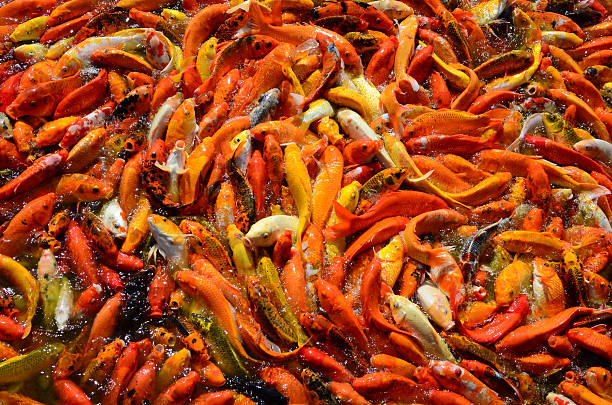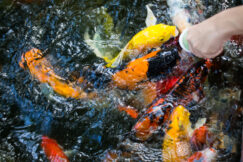Are you curious about the reproduction process of koi fish? Are you wondering how koi fish mate and lay their eggs?
If so, then this blog post is for you! We’ll explain the basics of koi fish reproduction and answer all your questions about this fascinating topic.
Introduction to Koi Fish Reproduction
Koi is a beautiful and fascinating fish species that has been popular in aquariums for centuries. They have a unique reproductive cycle that has been studied closely in recent years.
The breeding process begins when the koi reach sexual maturity, typically after 6 to 7 years. During mating, the male and female koi engage in a wrestling match and the female releases eggs that attach to breeding foliage and are met by the released milt, or sperm.
This event is spawning and can result in hundreds of thousands of eggs being laid. Several factors need to be considered to ensure successful breeding, such as water temperature and quality.
The Mating Cycle of Koi Fish
Koi fish reproduce by spawning, which occurs once a year. When the female is ready to spawn, she releases a pheromone to excite the male. The males then chase the female, often pushing her into the plant’s roots, the pond’s sides, or other areas.
When she is ready, she will lay eggs which the male then fertilizes. The cycle is repeated for about 6 to 7 years after they reach sexual maturity.
Breeding koi can be a rewarding experience for any fish keeper, and understanding the mating cycle of koi fish is an important part of ensuring successful breeding.
The Spawning Process
The spawning process of koi fish is an exciting event to observe. During the spawning process, the males become extremely aggressive and will pursue the females around the pond, smashing into them.
The mating ritual culminates with the female releasing her eggs, which attach to breeding foliage with the milt (sperm) released by the male. Before this happens, however, females prefer to release their eggs in areas with heavy vegetation and floating plants with submerged roots.
The female will nose potential breeding sites and egg attachment sites before beginning her wrestling match with the males. After the eggs are laid, they remain attached to plants and can take up to five days to hatch.
Do All Koi Breed?
Not all koi breed, as some conditions need to be met to reproduce. For instance, the fish must be sexually mature, and the environmental conditions must be right. Furthermore, both mature males and females are necessary for breeding.
It’s also important to note that koi may not breed every year, as this depends on various factors such as water temperature and quality. However, if all the necessary conditions are met, koi can have successful breeding seasons.
How Many Eggs Do Female Koi Lay?
Female koi can lay up to 100,000 eggs during breeding, though achieving this number is rare. Professional koi breeders usually estimate that a healthy 2-pound sexually mature koi in her prime can lay around 50,000 eggs during spawning.
However, some koi may spawn twice yearly, resulting in increased eggs during the first spawning. After mating once a year for 6 to 7 years after reaching maturity, female koi will lay their eggs, and the male will fertilize them.
What Happens After The Eggs Are Laid?
Once the female koi have laid the eggs, the male will release sperm onto them to fertilize them. This process is known as spawning. After this, the eggs will develop and grow and eventually hatch into baby koi fish.
This process usually takes about a week, depending on the water temperature and other environmental factors. The newly hatched koi will then continue to grow until they reach sexual maturity, at which point they can begin to reproduce themselves.
What Is The Best Time To Breed Koi?
The best time to breed koi is during the breeding season, which typically lasts from February through May when water temperatures reach 68˚F and koi reemerge from winter reclusion.
Experienced breeders usually place the male with the female in the late afternoon, and spawning usually happens just a few hours after. Feeding koi four times a day for a month before breeding can help increase the chances of successful breeding.
Since koi will only breed once a year, it is important to ensure that your male and female koi are at least two and three years old and at least 12 inches long before attempting to breed them.
What Factors Affect Koi Breeding Success?
When it comes to successful koi breeding, several factors can affect the outcome. At least one male and one female in the breeding pond are essential for successful koi reproduction. The male releases sperm onto the eggs after the female has dropped them.
Temperature also plays an important role, as koi will attempt to breed when temperatures signal that it is time. The number of eggs each female produces can vary, but it is usually enough to fill an Olympic stadium.
Additionally, koi males and females may look similar, making it difficult to determine their gender without proper examination. By considering all of these factors, you can increase your chances of successful koi breeding.
Conclusion
Koi breeding can be exciting and rewarding, but it’s important to consider the many factors involved to succeed. Understanding the mating cycle, spawning process, and optimal times for breeding are all key components to a successful koi breeding experience. You can have a successful koi breeding season with the right knowledge and environment.




